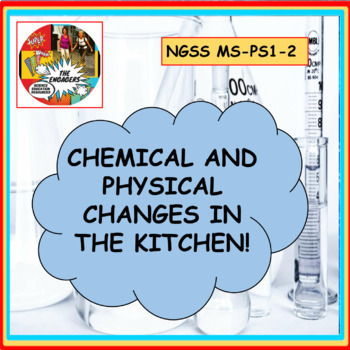Investigating Chemical and Physical Changes in the Kitchen NGSS MS- PS1-2
- Google Drive™ folder

Description
These engaging activities (GOOGLE and PDF versions) allow students to gain a greater understanding that the everyday substances that we drink and eat are chemicals and that chemical and physical changes are commonplace.
These activities can be done at home or in school.
Students will read about the differences between chemical and physical changes. They will then carry out 8 activities using foods commonly used in the kitchen and they will decide if the changes they observe are chemical or physical.
After discussion of these activities students will complete a summary worksheet and then they will write a food recipe outlining the chemical and physical changes taking place.
Easily obtainable materials are used for these activities (see list below).
Answers for the activities and summary statement worksheet are given in the detailed teacher notes.
Prior knowledge required before performing these activities:
- Matter is made up of very small particles that we cannot see (atoms and molecules).
The science and engineering practice below is incorporated in this investigation:
Developing and using models.
Included in this resource:
Teacher slides (21 slides)
Detailed teacher notes (8 pages)
Printable student worksheets with activity instructions and summary worksheet.(5 pages)
Sample answers for student worksheets
Suggested materials needed for students in the classroom or at home:
Ice cube
1 piece of bread
Small amount of sugar and salt
Pan and heat source (hotplate or stove)
Piece of chocolate
Uncooked egg
Don't forget to give a review for this resource to earn TPT credits towards future purchases!
Also, FOLLOW US to be notified when new products are added!
You may also like:
Stations investigating the three phases of matter NGSS MS- PS1 -4
Exploring the Many Dimensions of a Chemical Reaction NGSS MS PS1-2
Measuring the mass, volume, and density of a student! NGSS SEP aligned
Investigating density to find the main metal in U.S. pennies? MS PS1-2 CER SEP
Email any questions you have with subject line “Questions on activities to determine chemical and physical changes in the kitchen” to us at engagersinscience@gmail.com and we’ll be happy to answer them
Other teaching resources for sale in our Teachers Pay Teachers store can be accessed by using the link below:




